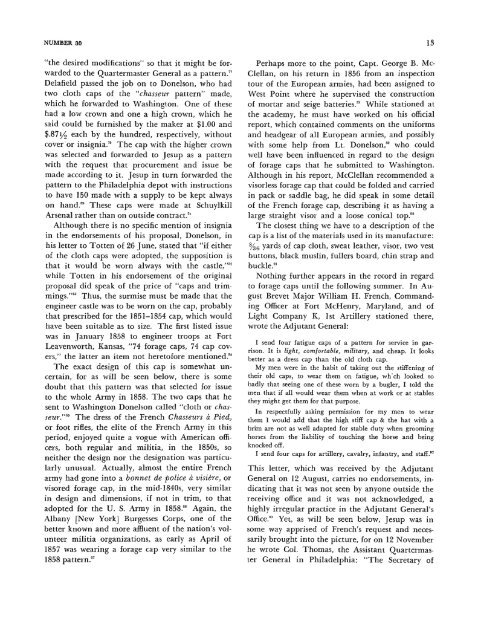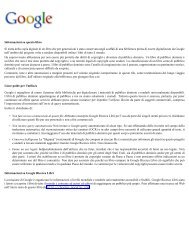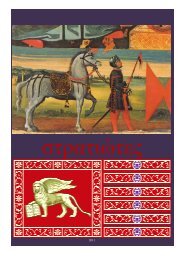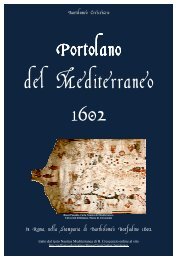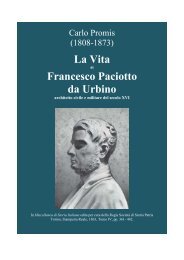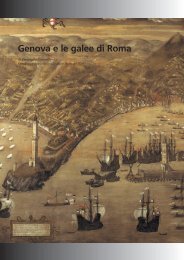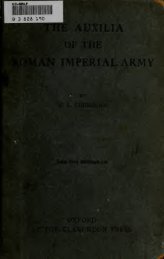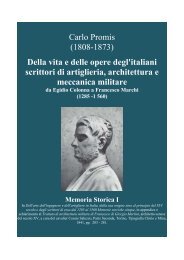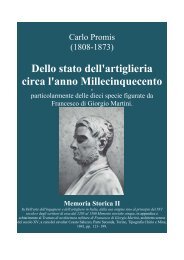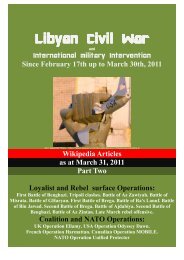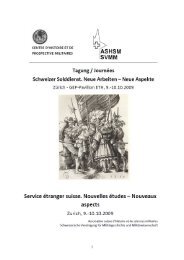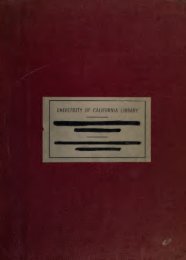12 SMITHSONIAN STUDIES IN HISTORY AND TECHNOLOGYmentioned in neither the 1861 uniform regulations,which were not published until 1862, nor in the1865 Quartermaster Manual.Of the officers' insignia, there is far less to go onand far more variation as to size. The 1861 regulationsspecified only that the staff and corps insigniawere to be gold or silver embroidered onblack velvet backgrounds. General and staff officerswere to wear a gold embroidered wreath, ofunspecified composition, encircling the silver letters"U.S." in Old English. Engineer officers wereto wear a gold embroidered wreath of laurel andpalm encircling a castle in silver, topographicalofficers a gold embroidered wreath of oak leavesencircling a gold embroidered shield. For officersof ordnance, cavalry, artillery, and infantry, goldembroidered shells and flames, gold embroideredcrossed sabers, edges upward with the number ofthe regiment in silver in the upper angle, gold embroideredcrossed cannon with the number of theregiment in silver at the intersection, and gold embroideredbugles with the number of the regimentin silver in the bend, respectively. No sizes werespecified. Since the 1865 Quartermaster Manualdealt only with issue items, no specifications weregiven for officers' devices. Examination of a numberof specimens reveals more uniformity in thesize of the black velvet backgrounds than in thedevices affixed thereon, the size of the devices averagingperhaps 10-15 percent smaller than those prescribedfor enlisted personnel. If the 1851 uniformregulations and the Schuyler, Hartley, & Grahamillustrations are taken as a standard, the documentedor biographical pieces examined matchrather closely, while the undocumented vary to agreater degree." Some officers' insignia in metallicimitation gold embroidery on black velvet backgroundsare known. All of the officers' hat cordsexamined carry acorns on the ends, similar to thoseon the <strong>1855</strong> cavalry hat, rather than the tassels onthe enlisted model.THE 1858 FORAGE CAPAlthough the 1851-1854 cap was an improvementover the 1832 and 1833 dress models, asstated above it quickly proved impractical for activeservice. In 1854, Inspector General SylvesterChurchill reported that at posts he had inspectedsince the previous June, officers queried opposedthe cap at a ratio of about two to one,'' and thecommanding officer of at least one regiment complainedbitterly about the unsuitability of the capfor wear in the field and especially for fatigue duty,and requested for his unit a reversion to the 1839pattern forage cap." Admittedly, this cannot betaken as representative of the opinion of the <strong>Army</strong>as a whole, but combined with the widespread wearof nonregulation broad-brimmed hats by officersand men alike of all arms during the period, it isstrong evidence that the cap was both disliked andimsuitable. A fatigue or forage cap was needed.In February 1857, Lt. A. J. Donelson, CommandingOfficer of the Company of Sappers, Miners, andPontoniers then stationed at West Point, wrote Bvt.Brig. Gen. Joseph G. Totten, Chief Engineer ofthe <strong>Army</strong>, pointing out the disadvantages of thecap, especially for engineer troops who were essentiallyskilled laborers, and suggesting either thatthe cap be retained for dress only and either theold forage cap or a felt hat similar to the cavalrypattern be issued for fatigue wear, or that such afelt hat be issued for both dress and fatigue. Hewent on to suggest further that if the 1851-1854caps were retained, the allowance might be a fatigueor forage cap each year and a dress cap thefirst and third years, the total issue of headgear forthe five year enlistment remaining unchanged."Major Richard Delafield, Superintendent of theMilitary Academy, passed the letter along with acovering letter of approval. Totten in turn endorsedthe concept and referred the proposal to theSecretary of War with the recommendation that the"Engineer Soldiers" be issued "two caps of thepresent style and five forage caps of the patternlately used [i.e., the 1839 pattern] . . with suchmodifications as may be necessary to adapt it betterto fatigue duty ... in lieu of the seven caps of thepattern now used." He pointed out that the costof the seven caps and trimmings was about -l^ 14.80per enlistment while those proposed would totalabout $11.25. The Secretary of War, John B. Floydapproved the suggestion on 31 March," and Delafieldwas instructed to have a forage cap made with
NUMBER 30 13"the desired modifications" so that it might be forwardedto the Quartermaster General as a pattern."Delafield passed the job on to Donelson, who hadtwo cloth caps of the "chasseur pattern" made,which he forwarded to Washington. One of thesehad a low crown and one a high crown, which hesaid could be furnished by the maker at |1.00 and$.871/2 each by the hundred, respectively, withoutcover or insignia. The cap with the higher crownwas selected and forwarded to Jesup as a patternwith the request that procurement and issue bemade according to it. Jesup in turn forwarded thepattern to the Philadelphia depot with instructionsto have 150 made with a supply to be kept alwayson hand.^" These caps were made at SchuylkillArsenal rather than on outside contract.^'Although there is no specific mention of insigniain the endorsements of his proposal, Donelson, inhis letter to Totten of 26 June, stated that "if eitherof the cloth caps were adopted, the supposition isthat it would be worn always with the castle,"^'while Totten in his endorsement of the originalproposal did speak of the price of "caps and trimmings."''^Thus, the surmise must be made that theengineer castle was to be worn on the cap, probablythat prescribed for the 1851-1854 cap, which wouldhave been suitable as to size. The first listed issuewas in January 1858 to engineer troops at FortLeavenworth, Kansas, "74 forage caps, 74 cap covers,"the latter an item not heretofore mentioned."The exact design of this cap is somewhat uncertain,for as will be seen below, there is somedoubt that this pattern was that selected for issueto the whole <strong>Army</strong> in 1858. The two caps that hesent to Washington Donelson called "cloth or chasseur."^The dress of the French Chasseurs a Pied,or foot rifles, the elite of the French <strong>Army</strong> in thisperiod, enjoyed quite a vogue with American officers,both regular and militia, in the 1850s, soneither the design nor the designation was particularlyunusual. Actually, almost the entire Frencharmy had gone into a bonnet de police a visiere, orvisored forage cap, in the mid-1840s, very similarin design and dimensions, if not in trim, to thatadopted for the U. S. <strong>Army</strong> in 1858.'° Again, theAlbany [New York] Burgesses Corps, one of thebetter known and more affluent of the nation's volunteermilitia organizations, as early as April of1857 was wearing a forage cap very similar to the1858 pattern."Perhaps more to the point, Capt. George B. McClellan, on his return in 1856 from an inspectiontour of the European armies, had been assigned toWest Point where he supervised the constructionof mortar and seige batteries.** While stationed atthe academy, he must have worked on his officialreport, which contained comments on the uniformsand headgear of all European armies, and possiblywith some help from Lt. Donelson,'" who couldwell have been influenced in regard to the designof forage caps that he submitted to Washington.Although in his report, McClellan recommended avisorless forage cap that could be folded and carriedin pack or saddle bag, he did speak in some detailof the French forage cap, describing it as having alarge straight visor and a loose conical top.""The closest thing we have to a description of thecap is a list of the materials used in its manufacture:%g yards of cap cloth, sweat leather, visor, two vestbuttons, black muslin, fullers board, chin strap andbuckle."^Nothing further appears in the record in regardto forage caps until the following summer. In AugustBrevet Major William H. French, CommandingOfficer at Fort McHenry, Maryland, and ofLight Company K, 1st Artillery stationed there,wrote the Adjutant General:I send four fatigue caps of a pattern for service in garrison.It is light, comfortable, military, and cheap. It looksbetter as a dress cap than the old cloth cap.My men were in the habit of taking out the stiffening oftheir old caps, to wear them on fatigue, wh'ch looked sobadly that seeing one of these worn by a bugler, I told themen that if all would wear them when at work or at stablesthey might get them for that purpose.In respectfully asking permission for my men to wearthem I would add that the high stiff cap & the hat with abrim are not as well adapted for stable duty when groominghorses from the liability of touching the horse and beingknocked off.I send four caps for artillery, cavalry, infantry, and staff.""This letter, which was received by the AdjutantGeneral on 12 August, carries no endorsements, indicatingthat it was not seen by anyone outside thereceiving office and it was not acknowledged, ahighly irregular practice in the Adjutant General'sOffice."" Yet, as will be seen below, Jesup was insome way apprised of French's request and necessarilybrought into the picture, for on 12 Novemberhe wrote Col. Thomas, the Assistant QuartermasterGeneral in Philadelphia: "The Secretary of
- Page 1: • ^ - :lP-'L^ry\'^ ^iT
- Page 4 and 5: ABSTRACTHowell, Edgar M. United Sta
- Page 7 and 8: ContentsPagePrefaceiiiThe 1855 Cava
- Page 9 and 10: United States Army Headgear 1855-19
- Page 11 and 12: NUMBER 30report, stated: "The hat p
- Page 13 and 14: NUMBER 30acorns %g inches long and
- Page 15 and 16: NUMBER 30the pattern." The rate of
- Page 17 and 18: NUMBER 30FIGURE 3.—1858 Army hat.
- Page 19: NUMBER 3011model, number 60 in the
- Page 23 and 24: NUMBER 30 15the sun in the top. The
- Page 25 and 26: NUMBER 30 17FIGURE 8.—1858 forage
- Page 27 and 28: NUMBER 30 19Hardtack and Coffee, ca
- Page 29 and 30: NUMBER 3021FIGURE 11.—a, Brigadie
- Page 31 and 32: NUMBER 30 23short "shell" jacket "f
- Page 33 and 34: NUMBER 30 26broad, securely soldere
- Page 35 and 36: NUMBER 30 27worn in the picture wer
- Page 37 and 38: NUMBER 30 29This communication elic
- Page 39 and 40: NUMBER 30 31FIGURE 17.—"The [Scot
- Page 41 and 42: NUMBER 30 33time for issue in the c
- Page 43 and 44: NUMBER 30 35be at too great a dista
- Page 45 and 46: NUMBER 3037half (5/2) part of washb
- Page 47 and 48: NUMBER 30 39trimmings for all enlis
- Page 49 and 50: NUMBER 30 41ing the upper space for
- Page 51 and 52: NUMBER 30rear one to a correspondin
- Page 53 and 54: NUMBER 30 46FIGURE 29.—1872 enlis
- Page 55 and 56: NUMBER 3047FIGURE 32.—^The Bent &
- Page 57 and 58: NUMBER 3049of strong split-leather
- Page 59 and 60: NUMBER 30 51''""MttfenFIGURE 35.—
- Page 61 and 62: NUMBER 30 53(which he thought might
- Page 63 and 64: NUMBER 30 55FIGURE 38.—Captain Be
- Page 65 and 66: NUMBER 30 57campaign hat for the Ar
- Page 67 and 68: NUMBER 30 59salvage something from
- Page 69 and 70: NUMBER 30 61hat. In June 1899 the P
- Page 71 and 72:
NUMBER 3063the left side, pass diag
- Page 73 and 74:
NUMBER 30 65.LJU^.."*^..FIGURE 44.
- Page 75 and 76:
NUMBER 30 67to be sent to Washingto
- Page 77 and 78:
NUMBER 30 69with brass sliding-buck
- Page 79 and 80:
NUMBER 30 71FIGURE 48.—Officers'
- Page 81 and 82:
NUMBER 3073The adoption of the whit
- Page 83 and 84:
NUMBER 3075i >•^\Wiii I ifiiiniim
- Page 85 and 86:
NUMBER 30this last model made no pr
- Page 87 and 88:
NUMBER 30 79WAR DEPARTMENT,QUARTERM
- Page 89 and 90:
NUMBER 3081FIGURE 58.—1864 chapea
- Page 91 and 92:
NUMBER 30geon 1880 and Surgeon Gene
- Page 93 and 94:
NUMBER 3085FIGURE 63.—1895 forage
- Page 95 and 96:
NUMBER 30 87of not less than 9.24 g
- Page 97 and 98:
AppendixMAKERS OF HEADGEARThe chron
- Page 99 and 100:
List of AbbreviationsAAGAAQMAGAGOAQ
- Page 101 and 102:
NUMBER 3093all OQMG, LS, Clothing,
- Page 103 and 104:
NUMBER 30 95"Jesup to Thomas, 8 Dec
- Page 105 and 106:
NUMBER 3097OQMG, Reg. LR, Clothing,
- Page 107 and 108:
NUMBER 30 99October of 1870. See Me
- Page 109 and 110:
NUMBER 30 101'"* See above, pp. 35-
- Page 111 and 112:
NUMBER 30 103Monroe, Va., in 1878.
- Page 113 and 114:
NUMBER 30 105""Endorsement, 24 May
- Page 115 and 116:
ReferencesThe bulk of the source ma
- Page 117:
M MBIiR 30 10910, No. 355-10, 19 Se


